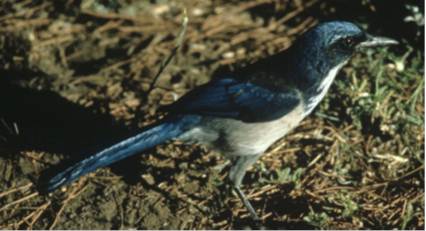
The Island Scrub-Jay (Photo provided by The Nature Conservancy)
Earlier this month global climate negotiations wrapped up for the 17th time in Durban, South Africa. An agreement to continue to talk and hopefully agree on a treaty binding to everyone by 2020 is progress of a sort. Meanwhile, scientific consensus predicts that if we keep doing what we're doing, global temperatures will increase 3.6 to 7.2 degrees Fahrenheit (2 to 4 degrees Celsius) by 2100, about the same level of warming that occurred following the Last Glacial Maximum almost 20,000 years ago -- except about 100 times faster. Certainly any effort to prevent the high end of that prediction has to be a top priority. But timetables for action, like the one that came out of Durban, suggest we're probably already locked into a big temperature increase, and we need to start preparing for the consequences.
With estimates that the world's population may hit at least 9 billion people by 2050, our legacy will be a world much different than the one we know. According to NASA , in 90 years most of Earth's land that is not covered by ice or desert is projected to undergo at least a 30 percent change in plant cover -- changes that will require people and animals to adapt and even relocate. The combined impact of a warmer planet and an extra 2 billion people will be jarring to say the least. It won't be easy, but people can move, and the lucky ones will. But many plants and animals will be trapped, unable to adapt in a world that is changing much faster than it has in the past and unable to migrate past man-made blockades like cities and highways. The reality is we're going to have to help them.
The island scrub-jay may be the new poster child for this challenge. It is the only island restricted bird species in continental North America. The only place you'll see one is on Santa Cruz Island, just off the coast of Santa Barbara, California. So it is going to be in trouble if climate change makes Santa Cruz Island unsuitable. A recent paper in the journal BioScience suggests a number of ways that could happen. For example, diseases like West Nile virus are becoming more prevalent with global warming, and when birds like jays get West Nile they tend to die. Fortunately, there are a number of things that we can do to reduce the risk of extinction of the jays -- like moving them to an island that is likely to stay cooler in the future. Two islands sure seem better than one in this case.
What's interesting about the case of the island scrub-jay is that while the bird appears to be doing fine right now, science tells us that there are problems on its horizon. This gives us the opportunity to think through what we can do proactively to reduce the threat of climate change. It will be a good test case because we're definitely going to need practice thinking through this kind of issue. What will we do when entire plant and animal communities can no longer make it in San Diego, their optimum climate shifting to San Francisco? How about species whose home habitats go away in other countries and a relatively short trip north just won't cut it? Is it zoos or oblivion? Or are there other options? This is startling talk to conservationists focused on protecting nature where it is today. But in reality humans have altered 75% of Earth's ice-free land. We are already changing and managing the planet -- just not by design. Helping the diversity of life adjust and survive the Age of Man even as we try to survive ourselves will be our biggest challenge since Noah built his ark. A little bird told me so.
